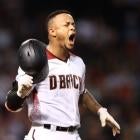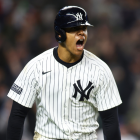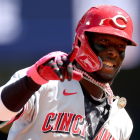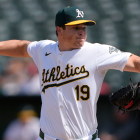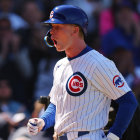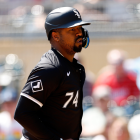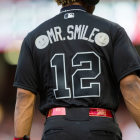In the world of baseball transactions, there is nothing better than a trade. Free agent signings are fun in their own way, sure, but for my money, trades are where it's at. There are more angles to analyze and you can't beat the challenge aspect: I think the players you're giving me are better than the players I'm giving you.
Three years and five months ago the Arizona Diamondbacks and Seattle Mariners finalized a blockbuster five-player trade that has since resulted in three All-Star Game selections (with more very likely to come) and one player on each side receiving MVP votes. Here are the details of the trade that went down on Nov. 23, 2016:
Diamondbacks receive
- IF Ketel Marte: 23 years old with five years of team control remaining
- RHP Taijuan Walker: 24 years old with four years of team control remaining
Mariners receive
- LHP Zac Curtis: 24 years old with six years of team control remaining
- OF Mitch Haniger: 26 years old with six years of team control remaining
- IF Jean Segura: 27 years old with two years of team control remaining
With all due respect, Curtis is a non-factor in the trade analysis. He was an up-and-down lefty reliever who was essentially a throw-in in the trade. Curtis pitched in 21 games with the D-Backs in 2016 and then appeared in only three games with the Mariners in 2017 before being lost on waivers. We should view the trade as Marte and Walker for Haniger and Segura.
Haniger appeared in 34 games with the 2016 D-Backs and was regarded as a solid prospect following a huge minor-league season that year, though he never appeared on a top-100 prospects list. Segura was a known commodity at the time of the trade. The veteran was coming off his best season (.319/.368/.499) and a 13th-place finish in the MVP voting.
Walker was a former top-100 prospect who had several stints with the Mariners from 2013-16. He made 54 starts with a 4.41 ERA in the two years prior to the trade and fatigue was setting in ("when is he going to figure it out?"). Marte debuted in 2015 and spent most of 2016 with Seattle, though his .259/.287/.323 batting line underwhelmed. That's where each player was at in their career at the time of the trade.
The three seasons since the trade have been a winding road for the two teams and the players involved. It looked one-sided in favor of either team at different points, and it's only now that we're starting to get a clear sense of which team came out on top. Let's revisit this five-player blockbuster, shall we?
Background

The D-Backs and Mariners both went into the 2016 offseason as pretenders looking to become contenders. Arizona fired GM Dave Stewart following a disastrous three-year tenure that saw the club lose 274 games from 2014-16, fourth most in baseball. At 69-93, they had baseball's fifth-worst record in 2016. Mike Hazen was hired away from the Red Sox to replace Stewart on Oct. 16, 2016.
"I don't have a defined view just yet. It would be irresponsible for me at this point to sort of say exactly how we're going to attack the roster," Hazen told reporters, including MLB.com's Steve Gilbert, during his introductory press conference. "We'll have more concrete answers on that as we move through the offseason. We'll see what the landscape is in the marketplace."
Arizona's rotation at the time was built around Zack Greinke, who was good rather than great in Year 1 of his new six-year contract, and Patrick Corbin and Robbie Ray. Corbin, an All-Star in 2013, stumbled in his first full season back from Tommy John surgery in 2016. Ray took a step back in 2016 following his breakout 2015 season. Those were the club's top three starters.
The depth behind Greinke, Corbin, and Ray was weak. Shelby Miller was an unmitigated disaster with the D-Backs and youngsters like Archie Bradley, Braden Shipley, Zack Godley, and Rubby De La Rosa had failed to establish themselves as big-league starters. The farm system was light on arms too. Anthony Banda was the team's top prospect at the time, but he was not an elite prospect.
The infield was an area of depth for the D-Backs, however. Segura was joined by Nick Ahmed, Jake Lamb, Brandon Drury, and Chris Owings on the big-league roster, with prospects Dawel Lugo and Domingo Leyba nearing their MLB debuts. A.J. Pollock and David Peralta gave Arizona two outfielders the team could build around as well. The organizational depth was in position players.
"Obviously, Jean is a great fit for them and was for us, but in order for us to get a starting pitcher the caliber of Taijuan, we felt like this was the opportunity we had to take, given the market," Hazen said following the trade, his first as D-Backs GM (via Gilbert). "... It's not one of those guys that you're able to acquire all the time, with the state of the game now with pitching and the premium, especially on starting pitching. We felt like this was an opportunity we needed to take."
The Mariners, meanwhile, went 86-76 in 2016 and finished three games behind the Blue Jays for the second wild-card spot. They finished one game behind the second wild-card spot in 2014 and were eager to get over the hump and end the sport's longest postseason drought. GM Jerry Dipoto was hired on Oct. 28, 2015, so the winter of 2016-17 was his second offseason on the job.
"Last year was about heavy lifting and effectively re-creating the way we played. This year is about focusing on ways we get can better in the parameters we set up last year," Dipoto told reporters, including Ryan Divish of the Seattle Times, in Nov. 2016. "... We still have a fair number of issues to address. We do have some holes on our major-league roster."
Offensively, the 2016 Mariners were built around lefty hitters like Robinson Cano and Kyle Seager. They gave more than 60 percent of their plate appearances to left-handed batters (63.4 percent to be exact), with Nelson Cruz the only notable righty presence. With Marte having a poor season in 2016, shortstop was an obvious spot to upgrade heading into 2017.
Seattle also needed outfield help. Badly. In terms of games played, their top four outfielders in 2016 were Leonys Martin, Nori Aoki, Seth Smith, and Franklin Gutierrez. Yikes. Yikes yikes yikes. Kyle Lewis, the No. 11 pick in the 2016 draft, was years away from helping. Tyler O'Neill was nearing his MLB debut, but clearly, the Mariners needed more than one outfielder.
"We do need some help in the corner outfield," Dipoto told Divish. "Right now, we are a little left-handed, and we'd like to get right-handed help."
James Paxton, Hisashi Iwakuma, and a still effective Felix Hernandez headed up a strong Mariners rotation at the time. Ariel Miranda flashed some promise late in 2016 and earned a longer look in 2017. Depth arms like Rob Whalen and Andrew Moore were in the farm system. High-end young starters like Walker are rarely expendable, but the Mariners had greater needs elsewhere.
"We just feel at this point, this trade made more sense with where our roster is, and Jean Segura fit this club about as well as any player we were looking at in the trade market," Dipoto told reporters, including MLB.com's Jane Lee, following the trade. "... It's hard any time you give up talent like Taijuan, but frankly you have to give to get, and in this case we feel like we're getting a little bit more of a known commodity."
Long story short, the D-Backs used their position player depth to add long-term help to their rotation while the Mariners used a top young arm to acquire two everyday position players. Two right-handed hitting everyday position players, I should note, seeing how lefty heavy Seattle's lineup was in 2017. Arizona also replaced Segura on the infield with an upside play in Marte.
2017: A win-win

We're all quick to anoint winners and losers following a trade (we're certainly guilty of it), but people in the game will tell you the best trades are the trades that work out for both sides. Win-win trades where everyone gets what they want are ideal and, in 2017, the Segura-Walker blockbuster looked very much like a win-win.
In Arizona, Walker had a marvelous season, pitching to a 3.49 ERA in 157 1/3 innings. His contributions plus drastic improvement made by Corbin, Greinke, and Ray -- those three allowed 234 runs in 554 innings in 2017 after allowing 261 runs in 488 2/3 innings in 2016 -- turned the D-Backs into a run prevention powerhouse. They led the club to 96 wins and a wild-card berth.
Marte split the season between Triple-A and the big leagues and hit .260/.345/.395 with five homers in 73 games with the D-Backs. For a 23-year-old switch-hitting middle infielder, that's quite promising. Walker amassed 2.6 WAR on the mound while Marte's all-around contributions added another 1.4 WAR to the ledger. The duo combined for 4.0 WAR in Year 1 post-trade. Not too shabby.
The 2017 Mariners did not have nearly as much success in the standings as the 2017 D-Backs -- they went 78-84 and finished seven games out of a postseason spot -- but Segura and Haniger did their part. Segura stepped in at shortstop and hit .300/.349/.427 with 11 homers and 22 stolen bases. He was the table-setter Seattle needed in front of Cano and Cruz.
Haniger missed time with oblique and facial injuries in 2017. In 93 games when healthy, he broke out with a .282/.352/.491 batting line and 16 home runs. He was the righty hitting corner outfielder Dipoto so desperately craved. The Mariners added the righty thump they needed to balance the lineup, they upgraded at short, and they brought in a building block outfielder.
Segura (3.5 WAR) and Haniger (3.1 WAR) outproduced Marte and Walker in the aggregate, though the D-Backs had a much better season, and besides, WAR is far too simplistic. The D-Backs acquired more years of control and the goal in 2017 was Walker and Marte establishing themselves as long-term contributors. They did that. It appeared both sides were getting what they wanted.
2018: Big Mariners win

The trade outlook took a drastic turn on April 14, 2018. Walker exited his start the evening, his third start of the new season, with forearm tightness. Four days later the D-Backs announced he would need Tommy John surgery. Rather than build on his promising 2017 season, the 25-year-old Walker would have to put his career on hold to get his elbow rebuilt.
Marte was Arizona's primary second baseman in 2018 and, in his first full MLB season, he authored a .260/.332/.437 batting line with 14 homers and an MLB-leading 12 triples. The 24-year-old added power without sacrificing contact ability. Marte's all-around game resulted in a 4.0 WAR-season. Walker's contributions in his three starts and 13 innings were negligible (0.1 WAR).
In Seattle, Segura and Haniger both put together All-Star seasons. Segura hit .304/.341/.415 with 10 homers and 20 steals, and because he signed a long-term deal in July 2017, Seattle had him locked up affordably through 2022. The Mariners had themselves a bona fide All-Star middle infielder signed through his prime. The dream scenario for any team.
The 27-year-old Haniger built on his strong 2017 season with a .285/.366/.493 batting line and 26 homers in 2018. He also rated as a standout defender in right field. By himself, Haniger accrued 6.2 WAR in 2018. Segura added another 3.2 WAR. Mostly though, the trade looked like a big win for the Mariners because Walker suffered a major arm injury, changing his long-term outlook.
Segura and Haniger propelled the Mariners to an 89-73 season in 2018, though it wasn't good enough to return to the postseason. They finished eight games behind the second wild-card spot. The D-Backs went 82-80 and finished 8 1/2 games out. Walker's injury combined with Ray taking a step back and Lamb and Steven Souza being hurt and unproductive did them in.
2019: Big D-Backs win

What a difference a year makes. With their postseason drought hitting 17 seasons in 2018, the Mariners committed to a rebuild last offseason and traded many prominent players, including Cano, Paxton, Segura, and Edwin Diaz. Segura, who was only 28 at the time, was sent to the Phillies with Juan Nicasio and James Pazos for Carlos Santana and J.P. Crawford on Dec. 3, 2018.
"We had an 89-win team (in 2018) with a negative run differential," Dipoto told reporters, including MLB.com's Greg Johns, following the trade. "We had an aging core that, frankly, most of the heavy lifting for our team was being done by guys in their mid-20s, guys like Mitch Haniger, James Paxton, Marco Gonzales, Edwin Diaz. Getting back to a younger core became a focus for us."
The Mariners flipped Santana to the Indians 10 days later for Edwin Encarnacion and a competitive balance draft pick, and later flipped Encarnacion to the Yankees for rookie ball pitching prospect Juan Then. All told, the final return in last winter's Segura trade was Crawford, Then, the draft pick, and several million dollars in payroll obligations. The Mariners went 68-94 following the tear down last season, their worst record since 2011.
Crawford split last year, his age-24 season, between Triple-A and MLB. He hit .226/.313/.371 in 93 games with Seattle and did flash upside at times. Crawford is under team control through 2024. They used the draft pick on Arkansas righty Isaiah Campbell. MLB.com ranks Campbell and Then as the 12th and 14th best prospects in Seattle's system, respectively.
Dipoto opted to keep Haniger rather than trade him as part of the rebuild last offseason. He started slowly in 2019, hitting .220/.314/.463 in 63 games before going down with what proved to be a season-ending ruptured testicle. Gah. Haniger then had two core surgeries over the winter. Had the 2020 season started on time, he would've opened it on the injured list.
For the Mariners, the Marte-Walker/Haniger-Segura trade now boils down to Haniger rebuilding value in 2020 (and 2021) and the three young players acquired in the Segura dealings (Campbell, Crawford, Then) panning out. As recently as 2018, the Mariners had two prime-aged All-Stars in Haniger and Segura. Now they have a reclamation project and three lottery tickets.
In Arizona, Walker was a non-factor in 2019. He completed his Tommy John surgery rehab and made one one-inning relief appearance in September, then was non-tendered after the season (he eventually signed with Seattle). For all intents and purposes, the D-Backs traded for four years of Walker but received only one good season (2017) due to the injury and non-tender. That aspect of the trade did not work out as hoped.
Marte is more than making up for it. He broke out as a legitimate superstar in 2019, hitting .329/.389/.592 with 32 home runs and 7.2 WAR. He successfully married his elite contact skills with his burgeoning power. Marte went to the All-Star Game and finished fourth in the NL MVP voting as the D-Backs went 85-77. They fell four games short of a postseason berth but have a talented core and a bona fide star in Marte to lead the way.
The D-Backs, it should be noted, wisely signed Marte to a five-year contract extension in March 2018. The contract includes two club options that could keep him in Arizona at below market salaries through 2024, his age-30 season.
2020 and beyond
Three seasons out, Marte is very clearly the best player in the trade. He's on the short list of the best players in baseball. Marte's best season (2019) was better than Haniger's best season (2018), and he's also quite a bit younger (26 to 29). Marte right now is younger than Haniger was when he had his huge 2018 season, and he doesn't carry the same injury concerns.
We also have to consider where the two teams are now relative to where they were when the trade was made. The Mariners made the trade to improve their offense and position player core, and get back to the postseason. That didn't happen. The postseason drought lives on and the club started a(nother) rebuild last offseason. It feels like Haniger will be moved as part of the rebuild before long.
The D-Backs have made one postseason trip since the trade (2017) and are set up very well going forward. Even with Walker getting hurt and non-tendered, Marte is a star, and the club's situation is so attractive that high-profile free agents like Madison Bumgarner are taking less money to go to Arizona. For a small-to-mid-market team, it gets no better than that. That's the dream scenario.
At the time of the trade both the D-Backs and Mariners were looking to make the jump from bubble team to contender. The Mariners never made that jump and had to start another rebuild. The D-Backs have not necessarily made that jump either, but they are much better positioned to do so in 2020. They got the best player in the trade and are set up better long-term. Getting from there to here has been a long, winding road, but it is clear Arizona has come out on top in this trade.













